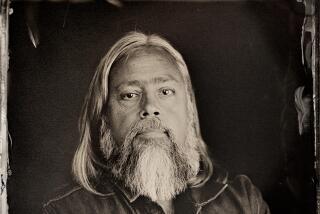An Anthology of American Indian Voices : NATIVE AMERICAN TESTIMONY: A Chronicle of Indian-White Relations From Prophecy to the Present, 1492-1992, <i> Edited by Peter Nabokov,</i> Viking, $25; 474 pages
The Wasco Indians of Oregon have a prophecy story, Peter Nabokov tells us, in which a wise man dreams of strangers with hair on their faces coming from the direction of the rising sun. When the old man wakes, he has this advice for his fellow tribesmen: “You people must be careful.”
It’s hard to believe any amount of care could have saved the Wasco and other American Indians from the conflict and suffering vividly illustrated in this collection of 100 American Indian voices. The last 500 years of North American experience constitute a major case of irreconcilable differences. A 19th-Century Creek chief, Speckled Snake, summed it up: “I have listened to a great many talks from our Great Father. But they always began and ended in this--Get a little farther; you are too near me.”
Nabokov’s anthology is divided into two parts, the first on confrontations with traders and missionaries and settlers; the second, beginning in 1865, on the world of the reservation. Having these witnesses to history in one book is going to be extremely useful for teachers and, less predictably, for writers looking for ideas for novels or screenplays. Still, “Native American Testimony” is not easy for the average reader. We have to shift between voices, without a Studs Terkel figure to keep continuity.
The story line is a dying fall; there is no wonderful reversal where all wrongs are righted.
There were at least 2 million people living in North America when Columbus came ashore; between 1492 and 1900, the drop in American Indian population was 90%.
Those lovable-looking Spanish padres who ran California’s early missions regularly used whipping and solitary confinement to keep their native labor in line. The farmers and gold miners who came to California between 1848 and 1870 were responsible for killing 50,000 American Indians between 1848 and 1870. In our century, the average age of death among American Indians is 40, and the infant mortality rate is more than twice the national average.
Although the narrative line of Nabokov’s collection is inexorably dismal, the story is rich in heroes. The Seminole (whose name means runaway ) have a group of warrior heroes, the 1,200 who escaped relocation in 1858 and permanently re-established their home in the Everglades.
Many of the heroes in Nabokov’s book are eloquent and supremely rational figures not as familiar to us as warriors like the Seminole or Sitting Bull or Cochise. There’s the Iroquois chief, Red Jacket, debating a missionary in 1828. “You say there is but one way to worship and serve the Great Spirit. If there is but one religion, why do you white people differ so much about it? Why do not all agree, as you can all read the book? . . . We never argue about religion.”
Necessarily, some American Indians show their eloquence in defeat. The most famous, Chief Joseph of the Nez Perce, ended his statement when he was caught fleeing for the Canadian border in 1877 with these much-quoted words:
“Hear me, my chiefs, I am tired; my heart is sick and sad. From where the sun now stands I will fight no more forever.”
There are plenty of villains. The impossibility of being fair, short of getting in boats and leaving, brought out the worst in many good Anglo leaders, including George Washington and Thomas Jefferson.
Judges fare better in history than administrators. The first chief justice, John Marshall, for example, ruled in favor of the Cherokee against the state of Georgia in a land grab case in 1831. A surprising hero is President Richard Nixon, who restored to Taos Pueblo in New Mexico 48,000 acres of the Carson National Forest, including the tribe’s sacred Blue Lake.
The short personal accounts chosen by Nabokov, and linked by his admirably clear historical narration, suggest a wealth of novels and movies. What was it like to be one in a small group of Blackfeet, for example, who went to Washington from Montana to explain to the Great White Father that they would rather not have a railroad through their hunting grounds?
A hero who cries out for his own movie (with Kevin Costner relegated to a bit part) is Standing Bear of the Ponca, who in 1877 told the story of his tribe’s 500-mile forced relocation to a disbelieving Omaha newspaper reporter. A third of his people died of disease and starvation.
When his son later died in Indian Territory, Standing Bear disobeyed the rule against leaving the reservation and carried his child’s bones back to the Ponca burial ground in Nebraska. After a Senate committee confirmed Standing Bear’s account, he and his followers were permitted to return to their Nebraska homeland.
Nabokov gives the last word to an anonymous Apache seer. “The old people used to tell us,” the Apache prophecy goes, “that when the end of the Earth is coming, all the water will begin to dry up. For a long time there will be no rain. . . . When the new world comes after that, the white people will be Indians and the Indians will be white people.”
If this is so, then we must be very careful.
Next: Jonathan Kirsch reviews “Crossing Antarctica” by Will Steger and Jon Bowermaster (Alfred A. Knopf) .
More to Read
Sign up for Essential California
The most important California stories and recommendations in your inbox every morning.
You may occasionally receive promotional content from the Los Angeles Times.









